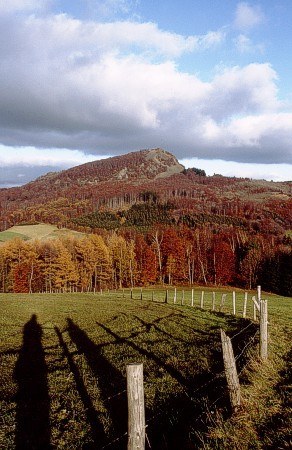 | ||
| Milseburg | ||
| federal state | Hesse | |
|---|---|---|
| Residents | unknown | |
| no value for residents on Wikidata: | ||
| height | 835 m | |
| no tourist info on Wikidata: | ||
| location | ||
| ||
The Milseburg is an 835 m high legendary basalt mountain in the Hessian Kuppenrhön.
background

Older names of the Milseburg are also Milsburg or Gangolfsberg (not to be confused with Gangolfsberg / Rhön near Oberelsbach). Geologically, the Milseburg phonolite cone is magma that has cooled slowly below the surface of the earth and penetrated into the layers of the red sandstone in the Tertiary era. After the erosion of the surrounding softer red sandstone, the harder basalt of the Milseburg remained, and the distinctive crest with its rubble heaps was formed.
This striking mountain figure has always stimulated the imagination of the people, and this is how many legends about the Milseburg originated.
A legend tells of the eponymous "giant Mils", who is said to have been up to mischief here together with the devil. Saint Gangolf then finally conquered him. Then the "giant Mils" killed himself. The Milseburg is now the giant's corpse covered with stones by the devil.
Another legend tells that in response to the building of a church on the Milseburg, the devil had promised an innkeeper a new tavern in just one day on the neighboring mountain. Since the construction of the church was supported by St. Gangolf, the Gangolf chapel was finished sooner than the inn, whereupon the devil out of sheer anger threw a huge rock on the almost finished inn. This stone is the neighboring stone wall, and on the Eselsborn near the stone wall haunts the devil in the shape of a three-legged donkey. Today there is an inn on the stone wall. The stone wall and then the tavern are worth a visit. The devil himself rarely appears.
Other legends tell of an eerie, secret and enchanted Gangolf cellar full of treasures, which nobody can find, of an image of Our Lady in the rock, or of a hermitage on the Milseburg called Johannes, called Milsehannes, who miraculously built the chapel out of the heaviest boulders built on the summit.
 North view from the Wasserkuppe. In the center of the picture the Milseburg  Milseburg from the Wasserkuppe, in spring |
getting there
In the street
Approach via the connecting road Hilders - small people - Poppenhausen (Wasserkuppe); Ascent to the summit on foot from the designated parking lot at an altitude of around 650 m. Walking time around 30 to 45 minutes one way. 1 Parking lot for hikers
By bicycle
On the Milseburgradweg of Fulda out. Instead of the tunnel, choose the challenging, signposted bypass. After driving through the tunnel, use the 10 to 12% asphalted eastern ramp of the tunnel bypass from the former Milseburg train station. The west ramp is a coarser gravel path that is just as steep. At the top, turn off towards the car park for Milseburg. From the car parking lot, the path is closed to cyclists. It makes no sense to continue driving anyway, as the path is very steep and rocky. It is best to connect the bikes in the area of the parking lot. The walking time from the car park is approx. 30 - 45 minutes one way. As a mountain bike enthusiast, please respect the driving ban, as many hikers are on the way.
mobility
Ascent to the summit from the designated parking lot: approx. 30 - 45 minutes (one way). The ascent is only possible on foot. Proper walking shoes are mandatory on the rocky path, especially when it is wet. Incidentally, the path is closed to bicycles.
Tourist Attractions
The phonolite dome, overgrown with rubble forests, shows the remains of a Celtic settlement with a ring wall. An archaeological hiking trail provides information about the excavations of the prehistoric oppidum, one of the largest Iron Age settlements in East Hesse from the late Bronze Age (1200-800 BC) and in the Iron Age (from 450 BC). The summit with the crucifixion group from 1756 and the Gangolf chapel offers one of the best views of the Rhön.
activities
- Enjoy the view
kitchen
1 Milseburghütte (835 m, hut of the Rhönklub main board). Tel.: 49(0)6684 919455, Mobile: 49(0)151 17841877. Simple hearty food and drinks for hikers, no accommodation. The first refuge was inaugurated in June 1884 and later rebuilt again and again. After a lightning strike in 1929, it was completely destroyed with the neighboring chapel and rebuilt. The current building was essentially built around 1959.Open: from Apr. to Oct. daily from 11 am to 8 pm until Good Friday, only Sat.-Mon .; Thursday rest day.
accommodation
- It is not possible to spend the night at the summit.
literature
- Joachim Jenrich: The Milseburg - pearl of the Rhön. Published by: Hessische Rhön Nature Park 2005, Verlag Parzeller Fulda, ISBN 3-7900-0371-9
- Willy Kiefer: Die Milseburg, 2nd edition 1999, Verlag Parzeller Fulda, ISBN 3-7900-0222-4 .
- The saga of the Franconian region and "The sagas of the Rhön Mountains and the Grabfeld", published by Ludwig Bechstein, Voigt and Nocker, Würzburg (1842), reprint in September 1979 by Rainer Hartmann, Sondheim v.d.Rhön --- in the antiquarian bookshop.


